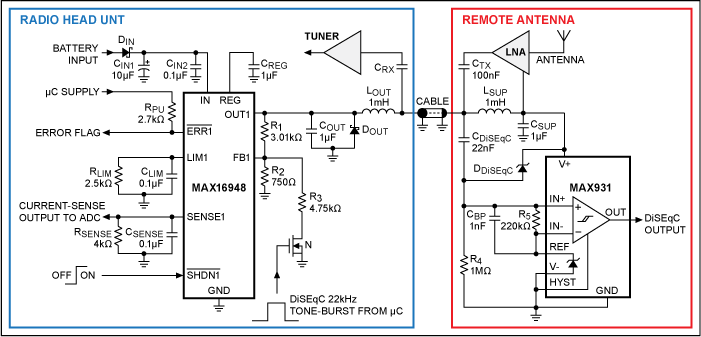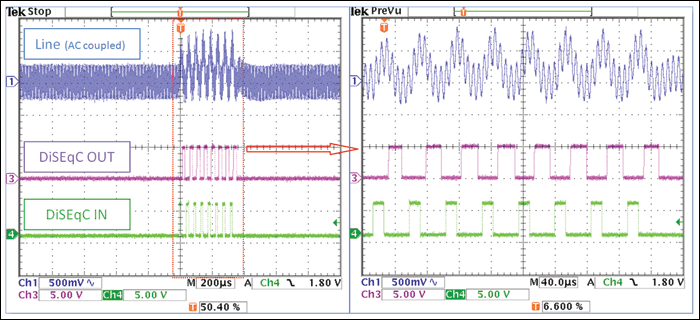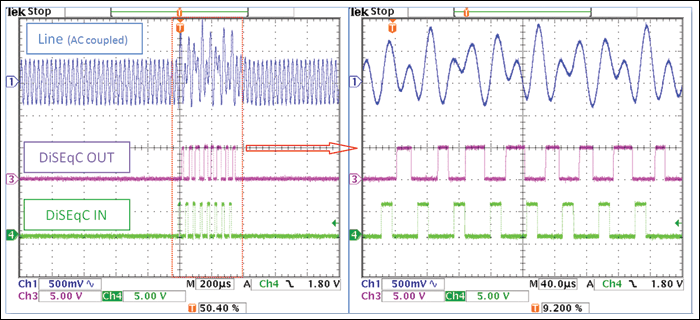Designing a Digital Satellite Equipment Control (DiSEqC)-Compatible Phantom Antenna Power-Supply System
Abstract
This application note discusses a design for a phantom antenna power-supply system compatible with the Digital Satellite Equipment Control (DiSEqC) communication standard, using the MAX16948 automotive dual, high-voltage LDO/switch. The presented application circuit provides a remote antenna power supply and also enables one-way communication from the radio head unit to the remote antenna. This system architecture offers flexibility in DiSEqC tone-burst frequency choice (100Hz to 30kHz), enabling users the ability to select the best frequency for their application.
A similar version of this article appeared in the November 2012 issue of Power Systems Design magazine.
The MAX16948 and DiSEqC Standard
The MAX16948 is an automotive dual high-voltage, low dropout linear regulator (LDO)/switch with output current sensing. The device provides phantom power over the coax cable to remote radio frequency (RF) low-noise amplifiers (LNAs) in automotive systems with a maximum current of 300mA per channel. The device provides a fixed regulated output voltage of 8.5V or an adjustable 1V to 12V regulated output voltage (LDO mode).
The Digital Satellite Equipment Control (DiSEqC) standard is a communication protocol developed by Eutelsat used between satellite receiver (decoder), defined as master, and satellite peripheral equipment such as dish switchers, low-noise blocks (LNBs) and dish positioners, defined as slaves. The DiSEqC communication system uses only the existing coaxial cable, thus making DiSEqC ideal to reduce cost and improve reliability. The DiSEqC is an open standard with nonproprietary commands.
To allow one-way DiSEqC communication on the phantom antenna cable, a 22kHz tone-burst must be transmitted from the radio head unit and received by the remote antenna. The voltage amplitude of this tone-burst is 650mV, which is the value indicated by the DiSEqC standard. Note that the phantom antenna coax cable is also used to feed the LNA and to transmit the received radio signal. For this reason, the DiSEqC receiver must be able to reject the radio signal on the cable.
Application Circuit
In the DiSEqC application circuit (Figure 1), the MAX16948 is used in LDO mode and the regulated output voltage is dynamically changed to generate the DiSEqC pulses. The blue block is the radio head unit, which includes the remote antenna power supply (MAX16948) used also as DiSEqC tone-burst transmitter and the tuner. The red block is the remote antenna formed by the physical antenna, the LNA, and the DiSEqC receiver (the MAX931 low-power comparator).

Figure 1. The DiSEqC application circuit.
The coax cable enables the communication between the radio head unit and the remote antenna (radio signal and DiSEqC tone-burst) and is also used to feed the remote LNA, saving cost and cable weight.
The MAX16948 is configured in LDO mode with a 5V voltage output when the external NMOS is turned off (DiSEqC tone-burst off). This output voltage is obtained dimensioning R1 and R2 resistors, as indicated in the MAX16948 data sheet and application note 5271, "Selecting External Components for an Automotive Dual Remote Antenna Current-Sense LDO/Switch." If a different remote antenna feed voltage (VOUT) is required, use the following equation to choose R1 and R2:

Where VFB is the voltage at the feedback pin in regulation (1V nominal) and R2 must be less than or equal to 1kΩ.
When the external NMOS is turned on, the R3 resistor is connected in parallel with R2. This brings the regulator output voltage to 5.65V. With this circuit configuration, a user can easily generate a DiSEqC 22kHz tone-burst by turning the external NMOS on and off through the microcontroller. If a different remote antenna feed voltage is required, choose an R3 resistor using the equation below:

RLIM and RSENSE set the output current limit to 200mA and the ADC full-scale range to 4V. (See application note 5271, "Selecting External Components for an Automotive Dual Remote Antenna Current-Sense LDO/Switch" for more information on choosing external components for the MAX16948.) For clarity reasons, only one channel of MAX16948 is reported on the schematic; the same considerations are valid for the second channel.
The output inductor (LOUT) is necessary to filter out the radio signal and to not conflict with the MAX16948 LDO regulator. Considering the AM band's lower frequency of 148kHz, a 1mH output inductor is sufficient.
The radio signal is extracted from the coax cable by the tuner with a bypass capacitor (CRX).
The remote antenna power supply used to feed the LNA is obtained through a lowpass filter built with inductor LSUP and capacitor CSUP. At a first approximation, the power-supply filter is an RLC lowpass filter (Figure 2).

Figure 2. Power supply filter.
The -3dB passband must be below the frequency used for DiSEqC communication.
The MAX931 low-power comparator acts as the DiSEqC receiver and is supplied with the same voltage supply as the LNA. The negative comparator input (IN-) is connected to the REF voltage provided by the MAX931 itself, while the positive comparator input (IN+) is polarized with a resistor divider (R4 and R5) in order to have zero voltage output on OUT in the absence of a DiSEqC tone-burst.
To sense the DiSEqC tone-burst, a 22nF capacitor (CDiSEqC) is connected between the coax cable and the negative comparator input. When a tone-burst is sent on the coax cable, the IN+ voltage exceeds the IN- voltage, which generates a pulse on the output of the comparator. A protection Schottky diode DDiSEqC is connected between IN+ and the comparator power supply input (V+) to avoid overvoltage on the IN+ pin.
To avoid false output pulse triggering due to the radio signal travelling on the cable, a 1nF bypass capacitor (CBP) is placed between MAX931 comparator inputs (from IN+ to IN-).
The radio signal received from the remote antenna and amplified with the LNA is injected onto the cable with a capacitor (CTX).
Bench Tests
Bench tests were performed generating eight 5V-amplitude 22kHz tone-bursts with a waveform generator connected to the gate of the external NMOS. A sinusoidal 500mV amplitude RF signal is obtained with another waveform generator and injected with the CTX capacitor, emulating the LNA output radio signal. The output of the MAX931 is monitored with an oscilloscope to confirm whether the sent tone-bursts are received and check that the injected radio signal does not influence the DiSEqC communication.
Figure 3a and Figure 3b illustrate the scopes of the performed tests. Figure 3a shows the results with an injected radio signal at 148kHz (500mV amplitude) that coincides with the lower AM band frequency. Figure 3b shows the results with an injected radio signal at 37kHz (500mV amplitude), which is the second subharmonic of the lower AM band frequency (148kHz).

Figure 3a. RF signal at 148kHz (500mV amplitude).

Figure 3b. RF signal at 37kHz (500mV amplitude).
Conclusion
The presented DiSEqC application circuit is a low-cost and flexible solution for an antenna phantom supply that is compatible with the DiSEqC communication standard. Additional bench test results have confirmed that DiSEqC communication still operates when selecting the DiSEqC tone-burst frequency in the range between 100Hz to 30kHz. This provides the flexibility to tune the most suitable frequency for DiSEqC communication, thus minimizing interference with other RF signals on the coax cable. Users can also regulate the tone-burst duty cycle and add hysteresis to the MAX931 comparator to attain the best DiSEqC communication performance.
This application circuit enables one-way DiSEqC communication; if a receive-acknowledge signal is needed from the remote antenna, it can be generated by modulating the load current of the MAX16948. A simple way to do this would be to connect an extra load in parallel to the LNA supply inside the remote antenna once the DiSEqC message is received. The microcontroller in the radio head unit can receive the acknowledgment by sampling the load current variation on the MAX16948's current sense output (SENSE). The switched extra load could be easily built up with an NMOS switch in series with a pullup resistor connected to the LNA supply inside the remote antenna.